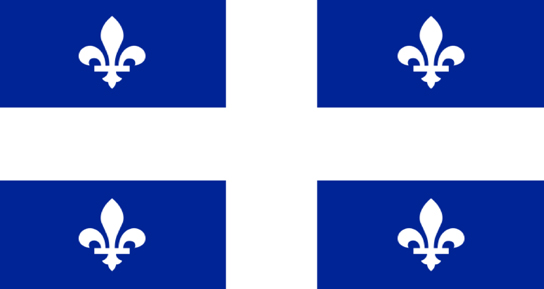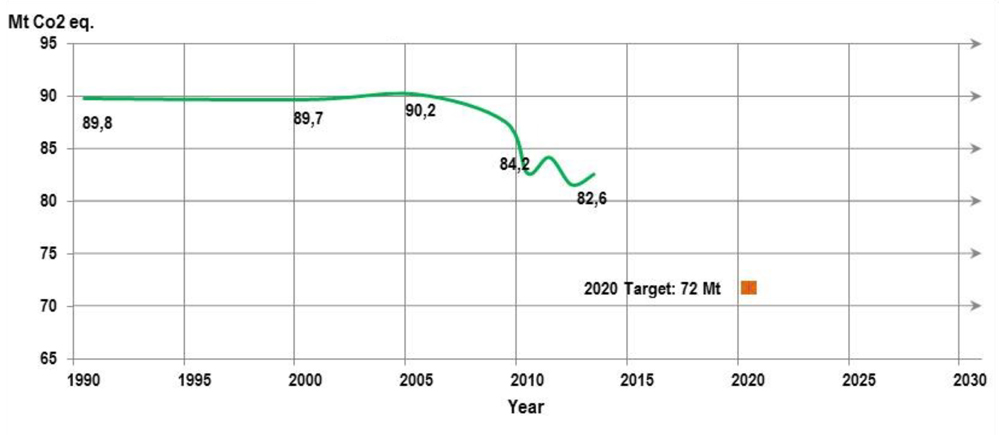Quebec: Environment profile
Note
This information was current as of November 2015.

Quebec (QC) in brief
- Premier:
- Mr. Philippe Couillard (Liberal Party)
- Population:
- 8,214,700 (2014)
- Total Area:
- 1,542,056 km 2
- Real GDP (gross domestic product) 2013:
- $331.2 billion (in 2007 dollars)
- Contribution to real Canadian GDP 2013:
- 19.4%
QC budget 2015-16
- Budgeted total expenditures:
- $98.6 billion
- Funds allocated to Ministère du Développement durable, de l’Environnement et de la Lutte contre les changements climatiques (MDDELCC):
-
$148.5 million
- 0.2% of total budget
- 3.3% decrease from 2014-15
Key environmental federal-provincial agreements
- Canada-QC Agreement on Environmental Assessment Cooperation
- Canada-Quebec Cooperation Agreement for the Protection and Recovery of Species at Risk
- St. Lawrence Action Plan 2011-2026
- An Agreement Respecting Ottawa River Basin Regulation
- Canada-Quebec Proposed Agreement on Acts and Regulations Applicable to the Quebec Municipal Wastewater Treatment Sector
Climate change
- Department responsible for climate change:
- Minister of Sustainable Development, Environment, and the Fight Against Climate Change (Ministère du Développement durable, de l’Environnement et de la Lutte contre les changements climatiques-MDDELCC)
- Minister responsible for climate change:
- Mr. David Heurtel
- Legislation and regulations:
- Environment Quality Act, Regulation respecting a cap-and-trade system for greenhouse gas emission allowances, Regulation respecting halogenated hydrocarbons, Regulation respecting greenhouse gas emissions from motor vehicles, Regulation respecting a tax on gasoline and fossil fuels, Regulation respecting the mandatory use of speed limiters in all trucks
Quebec GHG (greenhouse gas) emissions

Sources:
- Green Line: National Inventory Report (2015)
- 2020 Target: 2013-2020 Climate Change Action Plan
Long description
Figure 1 presents a single time series line graph with the horizontal axis spanning years 1990 to 2030 in five year increments. The vertical axis is in megatons of carbon dioxide equivalent and spans 50 to 100 Mt in increments of 10. The line begins at 89.8 Mt CO2 equivalent in 1990 and is relatively level until it begins to drop off after 2005 until reaching 82.7 Mt just before 2010, dropping to 82.6 around 2012. The graph also indicates that the 2020 emissions target is 72 Mt and that the 2030 target is 56 Mt.
Provincial GHG emissions reduction targets
- 6% below 1990 by 2012
- 20% below 1990 levels by 2020
- 80% to 95% below 1990 by 2050
- 2020 Target Equivalent to a 2005 baseline: 20% below
- Note: In September 2015, QC proposed a 2030 target of 37.5% below 1990 levels. Upon completion of parliamentary committee consultations, the target is expected to be announced in time for COP 21.
Quebec sources of GHG emissions, 2013

Source: National Inventory Report, 2015
Long description
Figure 2 presents a pie chart of the distribution of major greenhouse gas sources in Quebec.
- Stationary combustion sources: 29%
- Transport: 42%
- Fugitive sources: 0%
- Industrial processes: 13%
- Agriculture: 10%
- Waste: 6%
- Climate change strategies: 2013-2020 Climate Change Action Plan (2012); 2013-2020 Government Strategy for Climate Change Adaptation (2012); Transportation Electrification Strategy (2013)
- Total QC emmissions, 2013: 82.6 metric tonnes (Mt) (Source: Environment Canada’s National Inventory Report)
- QC contribution to total Canadian GHG emissions, 2013: 11.4%
- Ranked 3rd largest GHG emitter among Canadian provinces and territories in 2013
- GHG per capita, 2012: 9.7 tonnes; ranked lowest GHG emitter per capita in 2012
- On April 14, 2015, Quebec hosted a Summit on Climate Change which resulted in a declaration of the provincial and territorial Premiers.
- The flagship initiative of Quebec’s 2013-2020 Climate Change Action Plan is the cap-and-trade system which came into force in January 2013, creating Canada’s first carbon market. The system was linked with California’s cap-and-trade system in through a bilateral agreement. Emission credits can be bought or used in either jurisdiction.
- Other key initiatives include electrification of transportation and clean energy, energy efficiency and heavy oil reduction programs.
Water
- Department responsible for water:
- Minister of Sustainable Development, Environment, and the Fight Against Climate Change (Ministère du Développement durable, de l’Environnement et de la Lutte contre les changements climatiques—MDDELCC)
- Minister responsible for water:
- Mr. David Heurtel
- Legislation and regulations:
- Environmental Quality Act, Act to Affirm the Collective Nature of Water Resources and Provide for Increased Water Resource Protection (known as the Water Act), Water Withdrawal and Protection Regulation, Regulation respecting the charges payable for the use of water, Regulation respecting the declaration of water withdrawals, Regulation respecting the framework for authorization of certain projects to transfer water out of the St. Lawrence River Basin, Groundwater Catchment Regulation, Regulation respecting the quality of drinking water
- Water strategies: Strategy for Drinking Water Conservation (2011), Quebec Water Policy (2002)
- Quebec launched a Maritime Strategy which will focus on commercial ports infrastructure, logistic hubs and expanding marine tourism, and protecting biodiversity. The Strategy will support the work of the St. Lawrence Action Plan and incorporate Transport Canada objective of a World Class Tanker Safety System.
- MDDELCC is responsible for preventing/reducing water contamination, drinking water quality, and managing water within QC, assisted by two agencies: Centre d’expertise en analyse environnementale du Québec, and Centre d’expertise hydrique du Québec.
- Agreement with Ontario on water quality management for shared watersheds.
- Key water priorities include hydroelectricity, environmental assessment of shale gas exploration and extraction, management of the St. Lawrence River, and measures for blue-green algae.
- The objectives of QC’s 2002 Water Policy include recognizing water as a collective heritage belonging to the people of QC, protecting public health and aquatic ecosystems, and managing water in an integrated manner.
- The goals of QC’s 2011 Strategy for Drinking Water Conservation are to reduce average water consumption per person by 20%, and to reduce the leak rate for all water systems to 20% of the volume of water distributed.
Environment Canada and QC collaboration on water
- Ottawa River Regulation Planning Board
- St. Lawrence Action Plan 2011-2026
- Hydrometric monitoring
- Joint water quality monitoring
Biodiversity and wildlife
- Departments responsible for biodiversity and wildlife:
- Ministère du Développement durable, de l’Environnement et de la Lutte contre les changements climatiques (Biodiversity), Ministère des Forêts, de la Faune et des Parcs (Wildlife)
- Minister responsible for biodiversity and wildlife:
- Mr. David Heurtel (Biodiversity), Mr. Laurent Lessard (Wildlife)
- Legislation:
- Act Respecting the Conservation and Development of Wildlife, Act Respecting Threatened or Vulnerable Species, Act Respecting the Sustainable Management of the Forest Territory, Environment Quality Act, Forest Act, Natural Heritage Conservation Act, Tree Protection Act
- Biodiversity and conservation strategies: Orientations gouvernementales en matière de diversité biologique (2013)
| Extirpated | Endangered | Threatened | Special Concern | |
|---|---|---|---|---|
| Total: 80 Source: Species at Risk Public Registry January 2015 |
2 | 24 | 29 | 25 |
- QC adopted biodiversity guidelines in 2013 that are in line with the UN Convention on Biological Diversity’s Strategic Plan for Biodiversity 2011-2020 and Aichi biodiversity targets. The proposed approach is based on the three dimensions of sustainable development: living environments (environmental), ways of life (social) and living standards (economic). An interdepartmental steering group on biodiversity has been established to integrate the guidelines into the activities of ministries and agencies.
- QC’s Biodiversity Atlas, 2005, provides an overview of existing knowledge on QC’s threatened or vulnerable species, outlines related conservation efforts, and identifies biodiversity conservation priorities.
- The Interdepartmental Committee on Invasive Species is an inter-ministry committee that facilitates networking between ministries and agencies to develop a priority invasive species list, outreach materials, promote research, and a rapid response plan to fight against invasive species.
- As part of Plan Nord, QC’s economic development strategy for its North, by 2020 a network of protected areas will be established on at least 20% of the area covered by the Plan.
- Percentage of freshwater and land protected in QC: 9.7% (Source: Canadian Environment Sustainability Indicators, 2013)
- Environment Canada maintains 36 protected areas in QC, including 8 National Wildlife Areas and 28 Migratory Bird Sanctuaries, comprising over 58,000 hectares of QC’s protected lands and waters. Among the provinces, QC is home to the largest number of EC protected areas (25% of total protected areas).
- QC is home to nearly 40,000 species of wild plants and animals.
- The Quebec government sees forests as one of the main natural resources it can rely on.